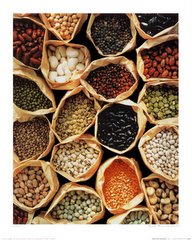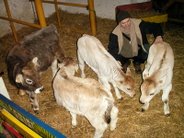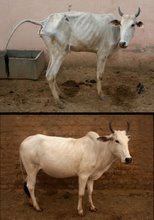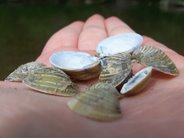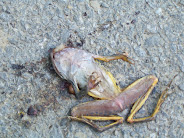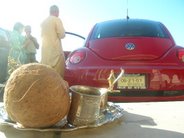Co-written by Aimee Blyth and Leslie Menagh,
Urban Agriculture Notes
Visible from either side of the Otonabee River, a mere five-minute stroll across the Trent University campus bridge, a rooftop garden and little café are working toward social and environmental change, specifically a shift in food culture.
For about a decade now, Professor Tom Hutchinson, a local farmer and ecologist, has been supervising an intensive vegetable garden on the roof of the Environmental Sciences building at Trent University. The reasons for the garden are many. Historically, it has provided a site for monitoring the effects of air pollution and smog on agricultural crops. More recently, it has served as learning space for students in the Food and Agriculture Emphasis Program at the school. And in Toms' own words, "it demonstrates our ability to use unused space for productive purposes. Since most people live in cities it behooves us to maximize the ecological aspects of the urban environment. Rooftop gardens clean up pollution and create esthetically pleasing, calming places to be."

Today, the garden grows organic food for local groups interested in food security and sustainable agriculture. Among these is The Seasoned Spoon Café. "The Spoon" as the restaurant is affectionately called, has a mandate to source its ingredients locally thereby reducing the energy it takes to transport healthy food to consumers. It is the only restaurant of its kind at the university as it is a student-run, independent co-operative that stands as a politically driven alternative to Aramark. The American food catering giant which predominantly provides food on campus contracts other corporations such as Tim Hortons and Pizza Pizza. So, like Tom's rooftop, The Spoon also provides unique opportunities for practical learning, from studies in small business operation to bioregionalism.
While most students are away for the summer, the rooftop and the restaurant have hired us: a gardener and a summer cook. With a shared love for all things gastronomic and growing, staff, volunteers, and Spoon customers are increasingly aware of the varied components of local food culture, and their interdependence. Spoon cooks can often be found weeding, sifting compost, or harvesting food, in turn deepening their appreciation for seasonality.
Whereas fast food may have been an attractive novelty some decades ago, we have seen a significant shift in the desires of eaters at the university and beyond, toward food that is ethically produced. It tastes better because the flavours are as fresh and varied as local farmers' produce. Furthermore, the price is as easy to swallow as any other food served at the school, and is often less costly. In fact, what we're seeing is that taste is determined by much more than what generically-produced, hyper-packaged products could ever offer - the ingredients of which have travelled farther than any human is likely to travel in their lifetime, chocked full of unpronounceable preservatives that enable it to do so. People like to feel good about what they're eating. It feels - and therefore tastes - better "to know that the means of production are ecologically and socially sound", says TimWilson, customer and member of The Spoon. And at the rooftop garden, we are committed to doing just that.
The Gardener's Story "What is it?", Scott, my fellow rooftop gardener asked.
I wasn't sure. I'd never seen this striking, green-black striped caterpillar before. We decided to leave it where we found it on the plant, and I went home to look it up; parsleyworm is its name. It eats the foliage of members of the umbelliferae family, including the parsley plant where we'd seen it. Like so many other gardeners, we were charmed by the beauty of this bug. One of my gardening textbooks - a rather dry book that I had thought contained no adjectives - describes the parsleyworm as "stunning". This little caterpillar, seems to have escaped the scorn that other garden pests command, such as the cabbageworm (which I, like most other gardeners, pick off whenever I see one). This distinction may not be without justification, however, as the parsleyworm, in the end, did little damage to our parsley crop. The trade-off was the later arrival of a another butterfly to the garden - a black swallowtail.

Working in the treetops among the butterflies, birds, bees and squirrels we cultivate vegetables, herbs, and edible flowers, including many heirloom varieties. Having never taken care of a rooftop garden before, I was surprised by the ways it differs from a traditional garden. The main differences can be summed up in two words: sun and wind. The resulting growing conditions tend to be more extreme. Even after a good rain, it takes very little time for the beds to dry out; our solution is mulch, mulch and more mulch. Even so, not everything grows well on the roof. In particular, we have difficulty with spinach, peas and beans. Other heat-loving plants, however, do very well including tomatoes, peppers and basil.
Another significant limitation on the roof is soil fertility. In the spring we recruit unsuspecting (or very generous) volunteers to help us haul compost from The Spoon. We further amend the soil with sheep manure from Tom's farm, green manure and compost tea. In particular using green manures or compost tea is labour-saving, because it precludes the need to bring more materials up to the roof through the Environmental Sciences Boardroom (the only access to the roof).
Despite these challenges, rooftop gardening provides a number of incentives. We need not worry about pests such as deer. Furthermore, what is a challenge in the summer - namely the warmer, dryer conditions - is an advantage in the spring when we're able to start gardening a few weeks earlier than the surrounding area. Thus the rooftop climate acts as a season extension.
Fortunately for us, the rooftop garden was a part of the initial building design. Thus, not only is there proper irrigation and drainage, but the building has sufficient load-bearing capabilities to support eighteen inches of saturated soil. To prevent water and roots from compromising the roof there is an impermeable membrane beneath the soil. The garden acts as a temperature moderator for the building below, cooling it down in the summer and insulating it in the winter.
On a larger scale rooftop gardens and sod roofs can do the same in a city. A recent study prepared by Ryerson University for the City of Toronto, found that green roofs significantly reduce stormwater runoff, reduce energy consumption and the reduce the heat island effect. Furthermore, they help to beautify the city and create more natural green spaces in urban areas - for everyone, including the black swallowtails.
Article continued at:
http://www.cityfarmer.org/TrentRoof.html
 by Michael A. Cremo & Mukunda Goswami
by Michael A. Cremo & Mukunda Goswami



